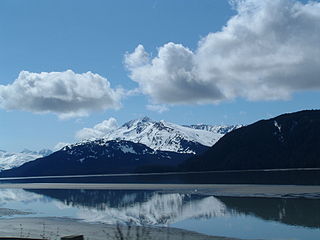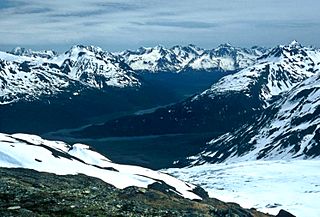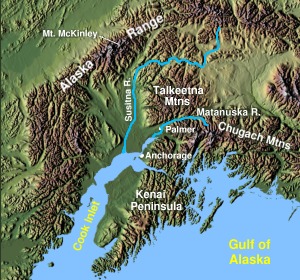
Bear Creek is a census-designated place (CDP) in Kenai Peninsula Borough, Alaska, United States. At the 2010 census the population was 1,956, up from 1,748 in 2000. Bear Creek is a few miles north of Seward near the stream of the same name and its source, Bear Lake.

Kenai Fjords National Park is an American national park established in 1980 by the Alaska National Interest Lands Conservation Act. The park covers an area of 669,984 acres on the Kenai Peninsula in south-central Alaska, near the town of Seward. The park contains the Harding Icefield, one of the largest ice fields in the United States. The park is named for the numerous fjords carved by glaciers moving down the mountains from the ice field. The field is the source of at least 38 glaciers, the largest of which is Bear Glacier. The fjords are glacial valleys that have been submerged below sea level by a combination of rising sea levels and land subsidence. The park lies just to the west of Seward, a cruise ship port. Exit Glacier is a popular destination at the end of the park's only road. The remainder of the park is accessible by boat, airplane, and hiking.

Turnagain Arm is a waterway into the northwestern part of the Gulf of Alaska. It is one of two narrow branches at the north end of Cook Inlet, the other being Knik Arm. Turnagain is subject to climate extremes and large tide ranges.

Hatcher Pass, also known as Hatcher's Pass, is a mountain pass through the southwest part of the Talkeetna Mountains, Alaska. It is named after Robert Hatcher, a prospector and miner. The nearest cities are Palmer and Wasilla approximately 12 miles (19 km) to the south, and Willow approximately 26 mi (42 km) to the west. The communities are at an elevation of approximately 250 ft (76 m) in the Mat-Su valley.

Bear Lake is near the town of Seward and Resurrection Bay, in the Kenai Peninsula Borough on the Kenai Peninsula in the U.S. state of Alaska. It is accessible from Bear Creek Road, which connects it to the Seward Highway. It is the site of salmon enhancement activities since 1962. This program is now managed by the Cook Inlet Aquaculture Association. Current projects at Bear Lake focus on increasing sockeye and coho salmon by controlling species that are predators and competitors.
Sixmile Creek is a short, approximately 12 miles (19 km) waterway with some of the most exciting whitewater rafting in Alaska. The Six Mile Creek drainage starts as Granite Creek flowing from the top of Turnagain Pass on the Seward Highway, part of the National Scenic Highway Program. Bench Creek and Center Creek join to become East Fork Six Mile Creek and Granite Creek is the largest tributary, contributing most of the water. At the confluence with Canyon Creek, it becomes Six Mile Creek which flows about eight miles to where it empties into Turnagain Arm shortly after flowing past the ghost town of Sunrise along the Hope Highway. There is a scenic outlook just before the Hope Junction with a grand view of the confluence of the creeks and the Canyon Creek Bridge that is pictured on the State of Alaska's website.

Gold mining in Alaska, a state of the United States, has been a major industry and impetus for exploration and settlement since a few years after the United States acquired the territory from Russia. Russian explorers discovered placer gold in the Kenai River in 1848, but no gold was produced. Gold mining started in 1870 from placers southeast of Juneau, Alaska.

Sheep Creek is located 4 miles (6.4 km) southeast of Juneau, in the U.S. state of Alaska. The Juneau community of Thane was originally called Sheep Creek. Draining an area of about 5 square miles (13 km2), it empties into Gastineau Channel. The valley formed by the river has a flat, gravel, trekking trail of 3.5 miles (5.6 km), south of Mount Roberts. The Snettisham hydroelectric dam substation is situated on a trail spur. Sheep Creek Hatchery is located at the outflow.

Candle Creek is a western tributary of the Kiwalik River, located on the Seward Peninsula of the U.S. state of Alaska. The unincorporated community of Candle is less than a mile away, while the village of Kiwalik is about 13 miles (21 km) away. The creek's name is attributed to the resemblance of the trees on the banks of the creek to candles when they are covered with snow. With the discovery of gold in 1901, Candle Creek's reputation as a top gold-yielding site was fixed.

The Kruzgamepa River is a 55-mile (89 km) tributary of the Kuzitrin River on the Seward Peninsula in the U.S. state of Alaska. The river begins at Salmon Lake, elevation 447 feet (136 m), and descends to 20 feet (6.1 m) above sea level at its mouth. In turn, the Kuzitrin River empties into the Imuruk Basin. The basin drains via the bay of Port Clarence to the Bering Sea.

Casadepaga River is a waterway in the U.S. state of Alaska, near Nome. It is the largest southern branch of the Niukluk River. It has a length of about 30 miles (48 km) and a general northeasterly course.
Eldorado River is a waterway on the Seward Peninsula]] in the U.S. state of Alaska. It is situated 14 miles (23 km) west of Solomon. This river has its source within a few miles of Salmon Lake, from which it is separated by a low divide. It flows southeast through a broad gravel-filled valley for 30 miles (48 km) to Flambeau River before emptying into Safety Sound. Its headwaters reach the limestones of the Nome series and much of its course lies in a chlorite-albite-schist belt. The Eldorado River provides a southerly drainage into the Bering Sea.
Minook Creek is a waterway in the U.S. state of Alaska. It is named after John Mynook Pavaloff, a half-Russian/half-native Alaskan, who found gold in the river's valley in 1894.
Eureka Creek is a tributary of Baker Creek in the U.S. state of Alaska. Other Baker tributaries in the vicinity of Eureka Creek include Thanksgiving, Gold Run, and Pioneer creeks with Seattle Junior Creek a tributary of Pioneer.
Crow Creek is a stream in the Chugach Mountains, Alaska, US. It is the only notable tributary of Glacier Creek, which enters Turnagain Arm from the north, 12 miles (19 km) from its eastern end. The stream is notable as the site of ongoing gold mining since the late 19th century.
Miller Creek is a stream in Yukon, Canada.

Glacier Creek is a stream flowing out of the Chugach Mountains, which enters the Turnagain Arm of Cook Inlet near Girdwood, Alaska.

The Resurrection River is a large river on the Kenai Peninsula in Alaska. It rises near Upper Russian Lake in the Kenai Mountains and flows 22 miles (35 km) to empty into Resurrection Bay near Seward. Part of the river passes through Kenai Fjords National Park. There has been small-scale placer mining for gold at the confluence of the river and Placer Creek.


















